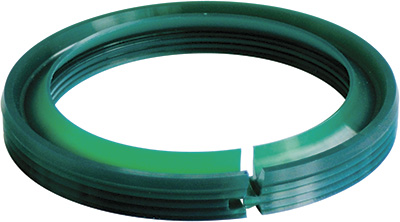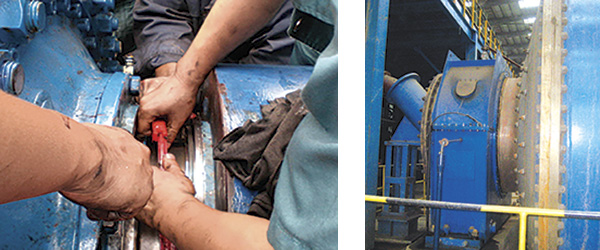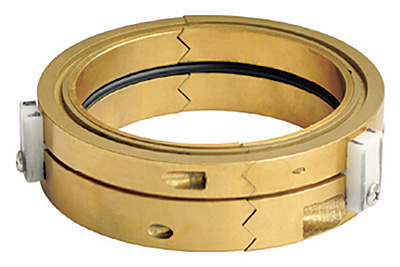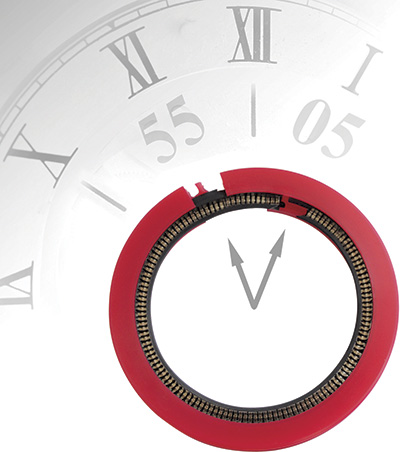Maintenance personnel usually dislike rotary seals. This is because replacing a low-cost oil seal requires dismantling a whole piece of equipment. If an employee sees a leaking reducer, the first step is to stop the reducer because of safety concerns. The next step is less clear. It is impossible to remove and replace the old seal with a new one because maintenance access is blocked by a shaft. The employee must shut off the line, separate the reducer from the connecting equipment, pull the cover off the shaft, find the old seal and pull it off the shaft. Finally, the employee can install a new seal, but now he or she must put the equipment back together in the opposite sequence. This process will likely take a few hours. If the shaft is more than one meter in diameter, the procedures could require several days. The cost varies based on the facility, but whatever the cost, it is far greater than the approximately $10 value of the oil seal.
 Image 1. Single split seal (Images and graphics courtesy of AIGI)
Image 1. Single split seal (Images and graphics courtesy of AIGI)Split Seals
However, replacing the seal without shutting down the line, separating the equipment and pulling the cover off the shaft is possible. A split seal can prevent most of this process. With a split seal, the equipment must be stopped, but the pipeline does not need to be shut down, and the equipment does not need to be dismantled. The cover must be pulled apart but not removed from the shaft. The split seal can be installed around the shaft, and the cover can be replaced. A split seal can turn a one-day job into a one-hour job or a few hours of work into a few minutes. These advantages are not helpful if the split seal is ineffective. The validity is difficult to determine, because each piece of equipment is different, and each plant has a different standard for leakage. The best applications for this type of seal are water or lubricants in extremely large equipment. This article will exclude the metal bearing protectors that are limited to less than 300 millimeters (mm) of shaft diameter and far more expensive than the equipment covered here. The seals discussed in this article are polymeric split rotary seals for large rotating equipment such as pumps, fans, motors and reducers. Most plants have these types of applications. The water unit areas of chemical plants and mines, for example, contain hundreds of large pumps. Tens of thousands of large pumps, reducers, fans and motors are used in power plants and steel mills. If the split seal works, plants could save millions of hours of manpower and avoid millions of hours of production downtime. Images 2 and 3. A split seal is applied in large equipment.
Images 2 and 3. A split seal is applied in large equipment.Single Split Limits
Many single split seals are on the market, and they can mostly perform without issues. While split seals can save money and prevent downtime, the single split design will not work, even in theory. Consider the easiest media to seal: light. Light is easier to seal than fluid because light does not bend, but fluid does. If a seal cannot stop light from leaking, it will not stop water or oil either. To test this theory for the single split seal, pull one apart by hand to make a gap that is 2 to 3 mm wide and hold up to a light source. If the cut is straight, light will immediately be visible from the split. But if the cut is V-shaped, light may not be visible. However, if the seal is viewed from above, it is easy to see through the split vertically. The water or lubricant can still move along the shaft and leak. Regardless of the cut, no simple shape can make the split area overlap both horizontally and axially during a pull-out.A More Effective Option
The alternative is to use two rings and two splits to meet the above requirements. With this new design, the pull-apart test can be repeated. Image 4. Split bearing protector
Image 4. Split bearing protector Table 1. Testing Report # MF-130710, Testing Standard: ISO 6194-4-2007
Table 1. Testing Report # MF-130710, Testing Standard: ISO 6194-4-2007In the Field
This design has also been proven in the field. During the past few years, more than 10,000 pieces of this ball and socket double split seal have been installed on various rotary equipment, fans, motors, reducers and pumps, including some extremely large equipment. One end user has purchased a 1.4-meter split seal for a rotary shaft in a steel mill every year for the past five years. That user saved a great deal in reduced labor costs and downtime by eliminating the need to dismantle such a large piece of equipment. Image 5. The positions of the splits on the double split seals
Image 5. The positions of the splits on the double split seals
